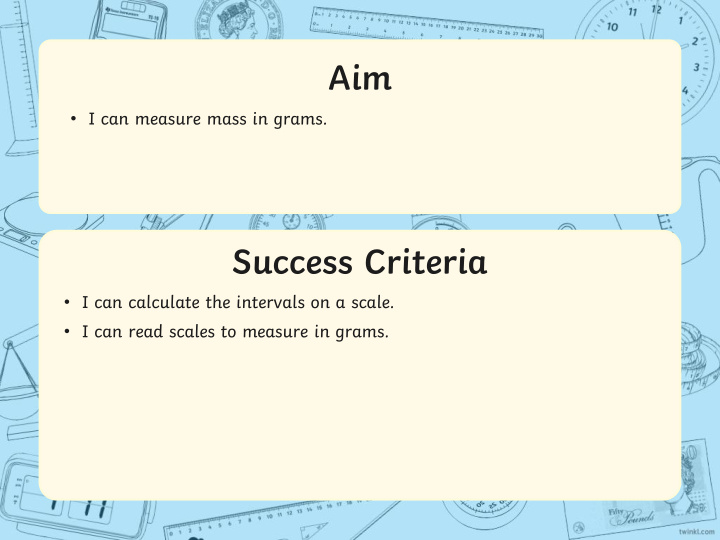



Aim • I can measure mass in grams. Success Criteria • I can calculate the intervals on a scale. • I can read scales to measure in grams.
Order It - Mass Work with your group to collect five objects. Order them from heaviest to lightest. Show your items and explain how you worked out the order. What strategies did you use to compare the items?
Estimate the Mass Look at the food items. Estimate their mass in grams and order them from heaviest to lightest. How close were your estimates to the real mass in grams?
Weighing in Grams A gram is a very small unit for measuring mass. A paperclip and a raisin both weigh about 1 gram. We can use a balance scale to weigh in grams by adding In a kilogram, there are weights until they balance with 1000 grams. the object you are weighing.
Weighing in Grams It is more accurate to use weighing scales to measure in grams. There are many different sorts of weighing scales:
Reading Scales We are going to learn how to use analogue scales . The first thing that you need to do is to work out what each interval of the scale represents. On this scale, there are 4 intervals between 0 and 100g.
Reading Scales We are going to learn how to use analogue scales . 100 ÷ 4 = 25, so each interval is To work out what each interval is worth 25g. worth we divide 100 by 4.
Reading Scales We are going to learn how to use analogue scales . If you look where the arrow is pointing, it is 100g plus one interval, so it is 100g + 25g = 125g
Reading Scales This is the same scale. What is the arrow pointing to now? The arrow is pointing 3 intervals after zero. 3 x 25g = 75g
Reading Scales On this scale, there are 5 intervals between 0 and 100g. To work out what each interval is worth we divide 100 by 5. If you look where the arrow is pointing, it is 200g plus two intervals, so it is 100 ÷ 5 = 20, so each interval is 200g + 40g = 240g worth 20g.
Reading Scales This is the same scale. What is the arrow pointing to now? We could also say: The arrow is pointing 1 interval The arrow is pointing 4 intervals before 200g. after 100g. 200g – 20g = 180g 100g + 80g = 180g
Reading Scales On this scale, there are 5 intervals between 0 and 50g. To work out what each interval is worth we divide 50 by 5. If you look where the arrow is pointing, it is 50g plus three intervals, so it is 50 ÷ 5 = 10, so each interval is 50g + 30g = 80g worth 10g.
Reading Scales This is the same scale. What is the arrow pointing to now?
Reading Scales This is the same scale. What is the arrow pointing to now? The arrow is pointing 1 interval after 150g. 150g + 10g = 160g
Reading Scales On this scale, there are 5 intervals between 0 and 25g. To work out what each interval is worth we divide 25 by 5. If you look where the arrow is pointing, it is 50g plus four intervals, so it is 25 ÷ 5 = 5, so each interval is 50g + 20g = 70g worth 5g.
Reading Scales This is the same scale. What is the arrow pointing to now?
Reading Scales This is the same scale. What is the arrow pointing to now? We could also say: The arrow is pointing 1 interval The arrow is pointing 4 intervals before 150g. after 125g. 150g - 5g = 145g 125g + 20g = 145g
Reading Scales On this scale, there are 10 intervals between 0 and 100g. To work out what each interval is worth we divide 100 by 10. If you look where the arrow is pointing, it is 200g plus five intervals, so it is 100 ÷ 10 = 10, so each interval is 200g + 50g = 250g worth 10g.
Reading Scales This is the same scale. What is the arrow pointing to now?
Reading Scales This is the same scale. What is the arrow pointing to now? The arrow is pointing 7 intervals after 800g. 800g + 70g = 870g
Measure in Grams Use your mass measuring mastery to complete these activity sheets.
Draw Your Own Using a pencil and ruler, draw your own scales and mark the mass shown. Label multiples of 100g on your scale. A scale showing 0 – 500g, in intervals of 50g. Mark 250g. A scale showing 0 – 500g, in intervals of 25g. Mark 375g. A scale showing 0 – 400g, in intervals of 20g. Mark 140g.
Draw Your Own Answers A scale showing 0 – 500g, in intervals of 50g. Mark 250g.
Draw Your Own Answers A scale showing 0 – 500g, in intervals of 25g. Mark 375g.
Draw Your Own Answers A scale showing 0 – 400g, in intervals of 20g. Mark 140g.
Aim • I can measure mass in grams. Success Criteria • I can calculate the intervals on a scale. • I can read scales to measure in grams.
Recommend
More recommend